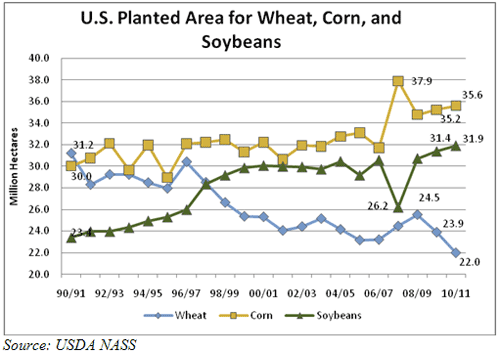Washington, DC, USA
July 8, 2010
Source: U.S. Wheat Associates
by Chad Weigand, USW Market Analyst
According to USDA’s June 30 acreage report, U.S. wheat planted acreage in 2010 fell by 4.8 million acres (ma) from last year. Lower prices and poor planting conditions caused a 13 percent reduction in winter wheat planted area to 37.7 ma. USDA estimates this year’s total wheat acreage at 54.3 ma, the lowest since 1971.

The largest acreage declines came in the top three HRW-producing states of Kansas, Texas, and Oklahoma due to the wet fall and lower farmer revenue potential. Kansas and Texas each showed 700,000-acre drops, while Oklahoma lost 500,000 acres. USDA estimates Kansas wheat plantings at 8.6 ma, the lowest total acreage since 1957. Texas acreage, at 5.7 ma, is five percent below the 10-year average, while Oklahoma’s 5.2 ma is the lowest since 1971. Estimated total 2010 HRW seeded area is 28.5ma, 10 percent less than last year. Despite the reduced acreage, improved yields should increase total production.
Soft red winter (SRW) acres showed a 30 percent decline from last year, dropping to 5.8 ma, the lowest in recorded history. The extremely wet fall in the Corn Belt delayed row crop harvests, leading to record low acreage in the top two SRW-producing states, Ohio and Illinois. Acreage fell by 21 percent in Ohio, to 800,000 acres, while Illinois’ 350,000 acres is 59 percent below last year and 44 percent below the previous low of 630,000 acres in 2005.
Hard red spring (HRS) acreage increased by five percent from last year, with increased acreage reported in North Dakota, Minnesota, and Montana. The promise of higher protein premiums provided incentives, and HRS planting in North Dakota and Montana offset reduced winter wheat acreage. Estimated total HRS acreage is 13.3 ma, on par with the five-year average.
U.S. Farm Program incentives helped increase durum plantings in 2010. The safety net in the USDA durum loan rate jumped to over $6.00/bu from approximately $4.50/bu and, as a result, durum acreage increased by five percent, to 2.7 ma. A nine percent increase in North Dakota durum plantings, to 1.8 ma, helped the state surpass Kansas for most planted wheat acres for only the fourth time on record.
The top three white wheat-producing states (Washington, Oregon, and Idaho) all reported increased wheat plantings. These three states combined for 89 percent of all soft white production in 2009, and all wheat acreage increased by a combined 145,000 acres in 2010 for these three states. Stronger export demand, higher premiums for club wheat, and lower prices for grass seed all persuaded PNW producers to increase wheat plantings.
Corn and Oilseed Crops Surge. At USW’s recent Latin American Buyer’s Conference, USW Vice President of Overseas Operations Vince Peterson and the Money Farm’s Mike Krueger discussed crop competition for acreage in the U.S. and the world. Both Peterson and Krueger indicate that the geography of crop production is changing as the opportunity cost to produce crops lagging in technology increases. USDA’s June 30 acreage report and the large overall decline in wheat plantings reinforce the long-term trend of growing corn, oilseeds, and other crops at the expense of wheat.
USDA estimates 2010 corn acreage at 87.9 ma, a two percent increase from last year and the second largest planted area since 1946. With wheat acres falling eight percent to 54.3 ma, the difference between corn and wheat acreage (33.6 ma) is the largest since 1943. Estimated soybean plantings are a record high 78.9 ma, creating the largest acreage gap in recorded history (24.6 ma) between soybeans and wheat.
The largest increases in 2010 corn plantings came in Kansas and Illinois, with both states planting 600,000 more corn acres. USDA estimates Kansas corn acreage at 4.7 ma, the largest since 1936. Corn acreage in Illinois grew to 12.6ma, second only to 13.2ma in 2007.
Both Kansas and Oklahoma planted record soybean crops this year, with Kansas soybean acreage growing by 11 percent from the previous year, to a 4.1 ma. Oklahoma increased soybean plantings by 19 percent, matching the previous record set in 1999 of 480,000 acres.
While North Dakota wheat acreage increased this year, canola acreage grew by 85 percent, to 1.4 ma. Corn acreage also increased in the state by 100,000 acres to 2.0 ma. At the Buyer’s Conference, Krueger offered one explanation: North Dakota’s yield index indicates that corn yields have grown by 82 percent since 1992, while HRS yields have only grown by seven percent – mainly attributed to advantages from biotechnology traits in corn. Wheat area planted, as a percentage of total acreage for North Dakota’s top four crops (wheat, soybeans, corn, and canola) sank to an all-time low of 55 percent in 2010. This is down from 71 percent in 2000 and 89 percent in 1990.
The trend for wheat planted area losing to other crops is not isolated to the United States. While drought hurt Argentina’s 2009/10 wheat crop, its soybean crop reached an all-time high of 54 MMT. Since Brazilian farmers started planting soybeans with biotechnology traits, production is up 35 percent, from 51 MMT in 2003/04 to a record 69 MMT of soybeans in 2009/10. Both Peterson and Krueger suggest the crop shift to corn and oilseeds may reach the Black Sea region. While small grains are still the major crops there, harvested area for soybeans has grown by 135 percent in Russia since 2002, compared to only seven percent for wheat.